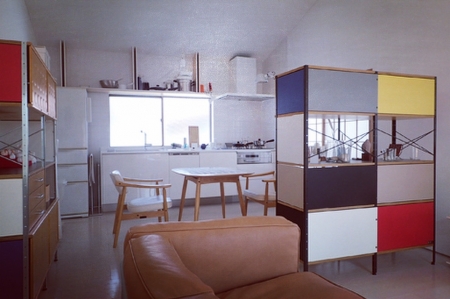建築のドレスとカジュアルのバランス
出かける時の服選びで色使いを一番最初に気をつける。出かける先がどこかによって、ドレスコードがあれば別だけれども、これから会う相手によっても、どこまでのドレス度で良いか、もちろん、ジャケットやスラックスなどのアイテムでもドレス度を調整するけれども、ジャケットは脱ぐ場合もあるし、そこでいつもファッションアドバイザーのMB氏による「ドレスとカジュアルのバランス理論」を参考にさせてもらっている。その理論によると、ジャケットでも明るめの色になるとドレス度が下がるので、場所によってはカジュアルになり過ぎて場違いになる場合もあるとのこと。
亡くなったAppleの創業者スティーブ・ジョブズが、パンツは通年ジーンズだったが、冬になると黒のタートルネックで過ごしていた。ファッションアドバイザーのMB氏による「ドレスとカジュアルのバランス理論」によると、黒は一番ドレス度が高い色、冠婚葬祭で使われる黒や白が一番ドレス度が高く、濃いグレー、濃紺などの黒に近い濃い色がそれに続き、赤や黄色などの鮮やかな有彩色が一番カジュアルに見え、それとタートルネックは襟の部分も高く、襟がある方がドレス度が高く、襟が無いTシャツはカジュアルに見えるとのこと。
だから、一見すると、スティーブ・ジョブズはいつもジーンズで、スーツなどと比べたらカジュアルで普段着のように思ってしまうが、それなりにドレス度が高く、かと言って、スーツほどでは無く、ドレスとカジュアルのバランスが適度に取れていたので、スーツだと入りづらいような所にも行けて、ほとんどの場所で出入りに不都合が無いとても合理的な服装をしていたことになる。
それは服選びに時間を割きたく無い、計算した上での服の組み合わせだろうが、アイテムとして一番ドレス度が高いセットアップでも、色が鮮やかな有彩色になるとカジュアルに見えてしまうので、たくさん服を持っていれば別だが、色でドレス度を調整して場違いにならないようにするのが一番手堅いかなと考えてしまう。
建築では今でもモダニズムの影響を受けているので白が多い。モダニズムにおいて建築は、それまでの物語性の強い建築から自律するために、仕上げに白を塗り込めて、白は色というより、それまでのものを消し自律性を高める役目として扱われていた。
建築の場合、白は自律性が高い色、自律性が高いと排他的で親しみやすさが薄れる、それを服の場合で例えると、やはりそれはドレス度が高いことになる。
モダニズムにおいても、多色を用いた形式、例えば、オランダのデ・ステイル運動などもあり、作品としてはリートフェルトが設計した住宅で世界遺産の「シュレーダー邸」や同じくリートフェルトがデザインした「赤と青のいす」が有名だが、実際に見てみると、多色を住宅ならば壁や天井、椅子ならば座面と背板や肘掛けといった要素ごとに色を塗り分けて、それぞれの要素の自律性を高めるために使用していた。ここでも多色は色というより、それまでのものを消し自律性を高める役目として扱われていた。
建築において色は面白い存在である。歴史的に見れば色はどちらかというと主役では無く、モダニズム建築において自律を手助ける役目を担っている。しかし、今、街を歩けば色だらけである。服でいうところのジャケットやスラックスと言ったアイテム毎の違いよりも、まず色の方が先に目に飛び込んで来て、それも有彩色でカジュアル度が高いものばかり、生活ではカジュアル度の高い建築空間に囲まれる機会の方が多い。しかし、そのカジュアル度の高い色は建築においては意識の外に置かれている。
出かける時の服選びで一番最初に気をつけるのは色使いだが、次に気をつけるのはドレスとカジュアルのバランス。これもおかしいと場違いになる。
ドレスとカジュアルのバランスを建築に置き換えて考えてみると、もしかしたら、何かが抜け落ちているかもしれないし、そのことによってかえって不自由で場違いな状況を招いているような気がする。そうなると、色は主役になってくる。
"A balance between casual and dress of architecture"
The first thing to be aware of is the use of color when choosing clothes when going out. Depending on where you want to go, it is different if there is a dress code, but depending on the person you are going to meet, how much dressing is good, of course, even if you adjust the dress degree with items such as jackets and slacks, if you take off the jacket There is always a reference to the "dress and casual balance theory" by fashion advisor MB. According to the theory, even if it becomes a bright color even with a jacket, the degree of dress will decrease, so depending on the location it may become too casual and out of place.
Apple founder Steve Jobs, who died, was wearing jeans throughout the year, but spent the winter in a black turtleneck. According to the fashion adviser MB's "Theory of Dress-Casual Balance", black is the most dressed color, black and white used in ceremonial occasions are the most dressed, dark gray, dark blue, etc. A dark color close to black follows, and vivid chromatic colors such as red and yellow look the most casual, and the turtleneck has a higher collar part, the one with a collar has a higher dressing degree, and the T-shirt without a collar It looks casual.
So, at first glance, Steve Jobs is always jeans, and when compared to a suit, it seems to be casual and casual, but the dress is rather high, so it's not like a suit, the balance between dress and casual I was able to go to places where it was difficult to enter with suits, and I was wearing very reasonable clothes without inconvenience in going out and entering in most places.
It is a combination of calculated clothes that do not take time to choose clothes, but even the setup with the highest dress degree as an item will appear casual when the color becomes bright chromatic, so many clothes I think that it is the most robust to adjust the degree of dress by color so that it does not get out of place.
The architecture is still influenced by modernism, so it is white. In modernism, architecture has been treated as a role that enhances autonomy by erasing the previous ones, rather than color, by applying white to the finish in order to be autonomous from the highly narrative architecture.
In the case of architecture, white is a color with high autonomy, and when it is autonomy, it is exclusive and less familiar. In the case of clothes, it is also a high degree of dressing.
In modernism, there are also multicolored forms, such as the Dutch De Steil movement, and the work is a house designed by Rietveld, a world heritage "Schrader House" and also "Red" The blue chair is famous, but if you look at it, you can paint different colors for each element, such as walls and ceilings for a house, seats and backboards and armrests for a chair. Used to increase autonomy. Here too, multicolor was treated as a role to enhance the autonomy by erasing the previous ones rather than colors.
Color is an interesting thing in architecture. Historically, color is rather the leading role, but plays a role in helping autonomy in modernist architecture. But now, walking around the city is full of colors. Rather than the differences between items such as jackets and slacks in terms of clothes, the color first jumps into the eyes first, and it is also chromatic and highly casual, with a high degree of casualness in life There are more opportunities to be surrounded by architectural space. However, the casual color is left out of consciousness in architecture.
When choosing clothes when going out, the first thing to notice is the use of color, but the next thing to watch out for is the balance between dress and casual. If this is also wrong, it will be out of place.
If you think about replacing the balance between dress and casual with architecture, it may be that something is missing, which in turn leads to inconvenient and out of place situations. When that happens, the color becomes the leading role.

